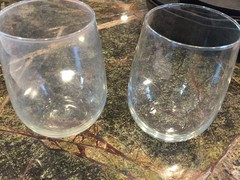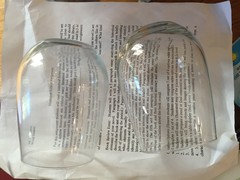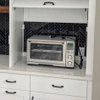Dishwasher grunge
aliris19
8 years ago
Featured Answer
Sort by:Oldest
Comments (37)
dadoes
8 years agoaliris19
8 years agoRelated Discussions
Might replace 5 yr old Miele dishwasher :( -need advice
Comments (117)I found this thread not only interesting, but it was also the kick in the pants that got me to do something about the repeatedly failing water intake valve/solenoid on my Miele Optima (G2420-SCI). The unit was installed new in 2008-2009. We moved into the house in early 2013, and by August that year we experienced our first failure. I do not know if the valve failed in the interval between 2009-2013. I called the local factory authorized installer, and they came out promptly. As I learned after the 2nd failure, they didn’t replace the entire hose/wire/valve, but simply cracked the case and wired-in a new valve. They charged me price of entire unit. Eighteen months later, same problem. I found some info on retrofitting the Miele valve with a GE valve, but I guess I was too timid to try it then. So, I called Miele and explained the problem. They comp’d me 33% on the new part, and this time they changed out the entire assembly. It worked fine until July ’16 when it developed same problem. This time they comp’d me the entire part and did another replacement. Every time they checked the inlet water temp it was below 130 degrees. The new part installed in August ’16 has barely lasted 8 months! We tried to use the machine over Easter weekend, and it came up with the same humming sounds of no water coming in and then popping off the “F12” fault code. After embarrassingly spending/wasting $1000 on 3 valve replacements, I finally decided to look back into the GE valve, and that’s how I got here. I was a GardenWeb member for years before Houzz, but lost touch, until I found this thread. Good x2. I followed the instructions on the YouTube video: https://www.youtube.com/watch?v=-LaqSO-Oyuw I opted to use the GE WD15X10003 valve as per the video, and not the WD15X93, mentioned earlier in this thread. As far as I could tell online, the two units are functionally comparable. The bracket and molded switch housing of the X93 are somewhat different, necessitated by the fact that the X93 is designed to be tucked into a cramped under-washer position in a GE system. It is also about $10 cheaper than the X10003, but the X10003 was available by Prime on Amazon, so I could fix it right away. I would guess that any of a number of these valves would be fine, since they would sit on the floor of the under-sink cabinet, and not require specific in-machine installation. The water inlet connection on the GE valve is a 3/8” Female iron pipe thread (FIP). My water source connector is a S/S flex hose with a 3/8” female compression fitting. To mate them I needed to pick up a 3/8” male-male brass connector with one end MIP and the other a compression thread. Connecting them was no problem, but getting them leak-free at the MIP-FIP connection was a bit of an issue. One has to hold the valve in one hand while tightening with the other and it’s hard to get a good grip on the valve portion. I used plumber’s tape first, but on the second try I used 1 wrap of plumber’s tape and a thread filler-sealer called “Hercules Block.” It’s a somewhat messy blue paste, but it did the trick. The wire connections were straightforward, just as explained in the video. I test ran it twice yesterday, and it worked normally, just as the OEM valve, and so far, there are no leaks. The time between failure and repair was only 3 days (not the typical Miele 3 weeks), and the out-of-pocket costs for valve, connector, sealer, electrical connectors was $40. (not $450+). The satisfaction of DIY, and un-shackling from the burdensome, confiscatory Miele system?....priceless. My only regret is that I should have done this after the 2nd failure...or the 3rd...slow learner, I guess....See MorePaneled Dishwasher options?
Comments (19)Nismo99 - did you decide on a model? Some additional info on our 4 year old LaPerla. I think the newest models all use the better racks but when we got ours, I didn't like the racks on the lower end versions, so take time to look at the racks. Joe pointed out the new model numbers got the version that pops the door open. It is definitely worthwhile for this option. Plastic dries- except if it has a ridge to catch water. I use sensor wash 95% of the time. I put both my giant Riedel and my traditional Waterford in my Miele. The Riedels fit on the lower rack. I put the Waterford on the top rack. I can put 4 Riedels in the bottom as they are quite large. There is plenty of room for my dinner dishes in addition to the wine glasses. The Riedels come out clean but I do get just a small water spot on the rim if I angle them. I just wipe it off with a microfiber cloth. My DH usually angles them and I place them more upright. My Schott pilsners fit on the top. Again, I usually only run 4 so I can put in other items. My giant Riedel pilsners go in the bottom Shh! I run the Riedels and Schott in my regular load using sensor setting unless I used my magic flute china and then run it on gentle. I have forgotten and ran the china on sensor as well Knock on wood - only one broken glass(just a regular glass and nothing special) DH was loading DW and clunked the rim of one of our 20 year old glasses and I heard it break he didn't even realize it. LOL I do use the Miele tabs. I used to use Cascacde powder and the Miele rep gave me some tabs to try. We use the whole tab but if your water is super soft, many cut them in half...See MoreLemiShine Laundry Booster powder-Littlegreeny
Comments (20)Since this has TAED in it, will it fade out dark fabrics? I would think it would even at a warm water wash. I didn't notice any fading in DD's clothing (mostly black) when I gave them this treatment with LemiShine laundry booster but if used regularly, would fading be accelerated? Greeny, last week I was in Target in another city and scoured their shelves for LemiShine laundry booster. No luck with finding it, but I did find their dishwasher detergent booster. I bought a bottle of that. I've used it twice now. The first time I got streaking on my glasses and flatware. I think I used too much. The 2nd DW load I used less (1/2 teaspoon) and no more streaking, so I think I'm zeroing in how much to use. My dishes were extremely clean and had a squeaky feel to them. Our water has gotten progressively softer as 2017 has rolled through. I think due to the heavy winter snows and our water table has been replenished with fresh snow water. With all that in consideration, other areas might need to use more than 1/2 teaspoon. I am a little confused on where/how to use the DW booster though. The label says to put the DW detergent in the pre-wash cup and put this booster in the detergent cup. I couldn't bring myself to do that because my DW runs a quick rinse at first run, then drains itself out. If I put the DW detergent in pre-wash cup it would be washed out in that initial rinsing. I put both products in the detergent cup and hoped for the best. What do you do? I use Cascade Complete DW pods 80% of the time and use Cascade powder the other 20%. The Cascade Complete pods work better in my DW, but I like to change it up a little when I need a lower dose of DW detergent....See MorePlumbing question -- what is causing this residue in my dishwasher?
Comments (21)Ok, folks - let's not jump to conclusions: There's nothing to suggest that it's "Bacteria or viruses" o anything like that. Let's rule something out though: If the drain line was clogged, or draining back, there would be water in the bottom of the dishwasher. We aren't seeing that. I don't think that's the issue. Of course a replacement isn't a bad idea. But it may be good to understand what happened here. I believe strongly that there is a base film of soap/scale from hard water, Then I believe that rust or tannins or both have created the red-brown color. It's slimy because it's soap residue mixed with hard water scale. Clean this up with vinegar as has been explained. I suspect it will take a few run-throughs with vinegar to get it cleaned up (buy the gallon jug of white vinegar). Once that's done, a run through with some bleach in the water wouldn't hurt. I suspect that this is on a well, and the water is very hard. It may not be hot enough also to fully dissolve the soap. The water was so hard at my last house I had to run a cup of vinegar through with each load of dishes. Usually I'd miss the last rinse and have to run an extra rinse. A water softer was a great thing at the new house....See Moredadoes
8 years agoaliris19
8 years agoFori
8 years agodadoes
8 years agoaliris19
8 years agodadoes
8 years agothull
8 years agoaliris19
8 years agolast modified: 8 years agothull
8 years agoaliris19
8 years agodadoes
8 years agothull
8 years agoFori
8 years agoaliris19
8 years agorococogurl
8 years agolast modified: 8 years agodadoes
8 years agoaliris19
8 years agomandy_elaine
8 years agorococogurl
8 years agolast modified: 8 years agoaliris19
8 years agodadoes
8 years agoaliris19
8 years agodadoes
8 years agoaliris19
8 years agolast modified: 8 years agoFori
8 years agoaliris19
8 years agodadoes
8 years agorococogurl
8 years agolast modified: 8 years agoaliris19
8 years agoFori
8 years agowwu123
8 years agodadoes
8 years agowwu123
8 years agoaliris19
8 years ago
Related Stories

FUN HOUZZEverything I Need to Know About Decorating I Learned from Downton Abbey
Mind your manors with these 10 decorating tips from the PBS series, returning on January 5
Full Story
HOUSEKEEPINGHow to Clean Your Range and Oven
Experts serve up advice on caring for these kitchen appliances, which work extra hard during the holidays
Full Story
MOST POPULARTrend Watch: 13 Kitchen Looks Expected to Be Big in 2015
3 designers share their thoughts on what looks, finishes and design elements will be on trend in the year ahead
Full Story
HOUSEKEEPINGChoose Your Own Spring Cleaning Plan
Instead of trying to do it all, pick one of these six cleaning approaches that’s right for you now
Full Story
SMALL KITCHENS12 Genius Design Moves for Small Kitchens
These space-enhancing tricks can make compact cooking zones look and feel larger
Full Story
KITCHEN DESIGNNew This Week: 4 Kitchens That Embrace Openness and Raw Materials
Exposed shelves, open floor plans and simple materials make these kitchens light and airy
Full Story
MOST POPULARYour Guide to 15 Popular Kitchen Countertop Materials
Get details and costs on top counter materials to help you narrow down the choices for your kitchen
Full Story
KITCHEN STORAGEStyle Your Open Kitchen Shelving Like a Pro
Follow these do’s and don’ts for arranging items on your kitchen shelves
Full Story
HOUSEKEEPINGHow to Relax and Put Housework in Its Place
If household disarray is making you stressed and unhappy, try approaching it with a different point of view
Full Story
SELLING YOUR HOUSEHow to Stage Your Kitchen for a Home Sale
Attract buyers with a kitchen that’s clean, bright and welcoming — no expensive overhaul required
Full Story







dadoes